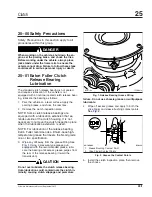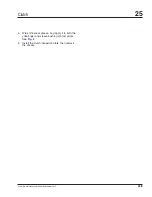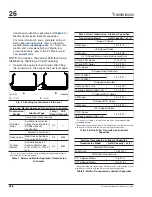
WARNING
If the engine starts during this procedure, the fan
could cause personal injury. If the vehicle is
equipped with an air starter, be sure that the air
starter reservoir is drained.
2.
Inspect the electrical connections and wires to
the fan clutch solenoid. Secure the connection if
loose; replace wires and connectors if damaged.
3.
Clean the fan clutch air solenoid valve filter, if
equipped.
3.1
Unscrew the fan clutch solenoid valve air
filter and remove its element.
3.2
Clean the filter element with cleaning sol-
vent.
3.3
Reassemble the clutch valve solenoid air
filter, then install it.
4.
Check the fan for bent, cracked, or damaged
blades. Replace if damaged. Check for adequate
clearance between the fan and other compo-
nents.
5.
Check the fan belt for wear, tension, and align-
ment. Correct as needed.
6.
Check for wear on the friction facing. See
Replace the friction facing if it is worn to a 1/16-
inch (1.6-mm) thickness or less. Also check the
facing for signs of oil contamination or burn
marks. If evidence of oil or burn marks are
found, replace the friction facing.
7.
Connect the battery cables. Start the engine, and
charge the air system to 120 psi (827 kPa). Shut
down the engine. Separate the halves of the fan
solenoid connector. The fan clutch should en-
gage.
If the fan does not operate correctly, see
Group
20
of the
Columbia® Workshop Manual
for
troubleshooting and repair procedures.
8.
With the air system charged to 120 psi (827
kPa), and with the fan solenoid connector halves
separated, check the fan clutch for audible air
leaks, using a suitable listening device.
9.
If a leak is detected, remove the fan blade. Using
a soapy water solution, check the fan clutch at
the following locations to find the source of the
leak. Install a new seal kit. See
Group 20
of the
Columbia® Workshop Manual
for repair proce-
dures.
9.1
Check for a leak at the bleed hole on the
fan pilot. Air leakage means the cartridge
assembly (
, Ref. 16) or face seal
(Ref. 17) is damaged.
9.2
Check for air leaks between the air cham-
ber and the piston friction disc. Air leak-
age means the large O-ring (Ref. 14) is
damaged.
9.3
Check for air leaks around the safeguard
hole on the piston friction disc. Air leak-
age means the small O-ring (Ref. 18) is
damaged.
9.4
Check for air leaking from the System
Sentry® fuse. Leaking air means the
clutch has gotten so hot the lead alloy in
the fuse melted. This released the clutch
before the heat could damage the clutch
bearings. Before replacing the fuse, find
and repair the source of the heat.
10. If equipped with an override toggle switch on the
dash, check fan clutch operation as follows:
10.1
Connect the halves of the fan solenoid
connector.
10.2
Turn off the air conditioner.
10.3
Start the engine and charge the air sys-
tem to 120 psi (827 kPa). Tests must be
performed with the engine temperature
below 205°F (96°C) for Caterpillar en-
f200290
1
2
08/08/94
3
4
5
1.
System Sentry® Fuse
2.
Safeguard Hole
3.
Friction Facing
4.
Piston Friction Disc
5.
Air Chamber
Fig. 5, Horton Advantage Fan Clutch
Engine Cooling/Radiator
20
Columbia Maintenance Manual, September 2015
20/4
Содержание CL112 2015
Страница 2: ......
Страница 4: ......
Страница 10: ......
Страница 32: ......
Страница 34: ......
Страница 38: ......
Страница 40: ......
Страница 42: ......
Страница 44: ......
Страница 46: ......
Страница 48: ......
Страница 50: ......
Страница 52: ......
Страница 60: ......
Страница 62: ......
Страница 66: ......
Страница 68: ......
Страница 74: ......
Страница 86: ......
Страница 94: ......
Страница 96: ......
Страница 104: ......
Страница 106: ......
Страница 116: ......
Страница 118: ......
Страница 120: ......
Страница 122: ......
Страница 128: ......
Страница 140: ......
Страница 142: ......
Страница 152: ......
Страница 156: ......
Страница 164: ......
Страница 166: ......
Страница 168: ......
Страница 172: ......
Страница 176: ......
Страница 178: ......
Страница 180: ......




































